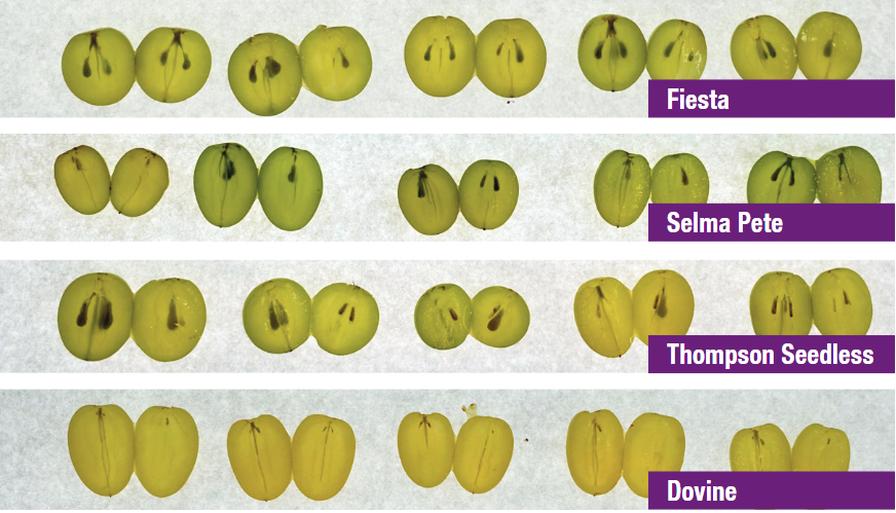Understanding Seed Traces in Your Seedless Grape Crops
Consumers want completely seedless raisins and table grapes. But with few exceptions, “seedless” grapes are stenospermic — not technically seedless. With stenospermic varieties, seed development is abnormal, aborting before the seeds are fully developed.
Specifically, pollination leads to ovule fertilization and embryo development, but the endosperm degenerates, and the seed coat fails to harden. The number, size, and hardness of the aborted seed remnants, or traces, can vary from imperceptible to plainly noticeable, depending on the grape variety and the environmental conditions at bloom and throughout the course of seed development.
Varietal selection is the most fundamental way to avoid seed trace issues. Varieties with the smallest seed traces typically abort seed development at an early stage, where seed development continues for a longer period in varieties having larger seed traces.
WEATHER CONDITIONS
Stenospermic varieties exhibit a range of seed trace development potential, and the underlying genetic factors responsible for stenospermy also may interact with environmental conditions, particularly temperature, to affect seed trace size. Unusually high temperatures may promote the development of noticeable seed traces, and seedless varieties selected in cool climates may produce larger seed traces when grown in a place with a warmer climate. On the other hand, cooler temperatures during bloom also may allow embryos to survive longer, becoming bigger and more noticeable.
Last spring (2021) in the San Joaquin Valley of California there were periods of both cooler than normal and warmer than normal weather. By the end of the season, several raisin and table grape growers had observed unusually prominent seed traces in certain varieties. Some of the raisin vineyards also had insufficient water. These water-stressed vineyards had worse seed trace problems than vineyards that received better care.
It seems a range of environmental stresses might stimulate seed trace development in some varieties. Seeds, or noticeable seed traces in varieties that are normally considered “seedless,” are a quality defect and should be avoided if possible. However, cultural practices to manage seed traces, aside from good care, are limited, especially for certain varieties.

Cross sections of raisin grape berries from different varieties showing variation in the number and size of seed traces in these “seedless” grapes.
Photo by Stephen Vasquez, Sun-Maid
PLANT GROWTH REGULATORS
Gibberellic acid (GA), a plant growth regulator, can reduce the number and size of seed traces in grapes. Many table grape varieties are normally treated with GA for cluster management (rachis elongation, and fruit thinning and sizing), and those treatments also may help minimize seed traces. However, some grape varieties, such as ‘Fiesta’ (a raisin grape), are prone to developing seed traces, but also sensitive to GA. In such varieties, the possible benefits of GA may not be worth risks of over-thinning, bud necrosis, and/or reduced fruitfulness the following season.
Although GA has been repeatedly shown to help reduce seed trace size, antigibberellins and other plant growth regulators, including cytokinins, can potentially increase seed trace size. Antigibberellins are not presently registered for use on grapes in the U.S., but some cytokinins are. Testing to determine possible effects of such products on seed trace size might be warranted in vineyards with unusually large seed traces.
Other factors possibly affecting seed trace number and size include vine age. Younger vines tend to have grapes with larger seed traces than older vines. Rootstock may also affect seed trace size, but data are limited. Own-rooted vines appear to have worse seed trace issues than vines on rootstocks. The possibility of reducing seed trace content is another potential benefit of rootstocks, which are normally used to help avoid damage from soil pests.
The surest way to minimize seed trace issues in seedless grapes is to select grapevine varieties that are known to have minimal problems when grown in the same region, or other regions with similar climates. Grafting onto an appropriate rootstock might provide further benefits, and the use of GA for cluster management also could be beneficial, depending on the variety. However, some grape varieties are sensitive to GA. These varieties should not be treated without conducting some on-farm trial experience and consulting with a qualified Certified Crop Adviser or Pest Control Adviser.
Matthew Fidelibus has a Ph.D. in Horticultural Sciences from the University of Florida, and he has served as a Cooperative Extension specialist in the Department of Viticulture and Enology at the University of California-Davis, since 2002. See all author stories here.

